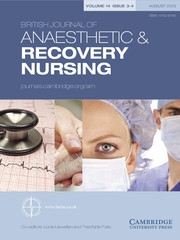PACU: A Well-oiled Machine
I am currently going through the process of interviewing for new band 5 PACU nurses on my unit. One thing that strikes me about this process, compared to when I was in other specialities, is how much emphasis I place on the individual being able to gel with the rest of the well-oiled team. Of course, teamwork is important in all areas of nursing, but only did I find the true benefits of it once I had discovered PACU. I think this is down to a few factors, but the very nature of the PACU experience seems impossible without the effective teamwork needed and surprisingly hindered if not taken seriously.
I recently had the pleasure of working with a new nursing student. She was coming up to the end of her first year and when asked about what she had enjoyed most about our unit, she replied that it was watching how well the team worked together, how we interacted and helped each other out. Surely, this should be a standard, but I guess I’m just lucky. So, my message in this journal is not to underestimate the power of a well-oiled machine.
During a brief look at some of what student nurses have said about the PACU speciality on Internet blogs, I came across this one. I will leave you with a short section of it and invite you to remember the power of teamwork and the first impression when dealing with the student nurses.
It’s official. I am in love with the PACU. Post Anaesthetic Care Unit that is.
Basically, this unit is a fast paced, on your toes, better know your P’s and Q’s kind of place. That’s where I went today with two other class mates. It was amazing.
Here’s how it works. There were 12 beds open. Today, they were short a nurse so we were only working 8 beds. Patients roll in from the theatre to the PACU because this is the recovery room. Each nurse gets 2 beds. The first patient goes to bed 1, second to bed 3, then 5 and 7. After each nurse gets their first patient, it goes around again on the even numbers. PACU patients are there for an hour or so before being transferred to the ward, although they are often in the unit longer for various reasons.
Vital signs are checked every 15 minutes and your assessments better be spot on. You also have to monitor fluids going in and make sure the dressings from surgery are dry and intact. If there is too much bleeding you have to notify the right people immediately as they may have to roll back to theatre. Depending on what kind of surgery they have had, your assessment focus changes. For example, a patient with back surgery, you want to make sure they can move their legs and still have sensation, while with a heart patient you are monitoring their rhythm strips.
The neat thing about the PACU is that it can start off slow, but as soon as the first surgery rolls in, you hit the ground running. The patient rolls in and you all jump right in there. Someone is charting the observations while someone else is hooking their leads to the monitor and someone else is hooking up the oxygen. The level of teamwork is amazing.
The PACU nurses are unbelievable. They’ll be taking report from the anaesthetist and listening to the various people calling out data and charting it all at the same time. They can listen to the breath sounds of the patient to see if they’re clear or wheezing, crackling, etc, while counting how many breaths they take in a minute at the same time. It’s amazing.
Taken from Nursing Student Chronicles


